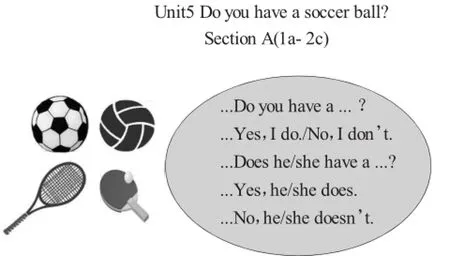Un it5 Do you have a soccer ball?Section A(1a-2c)教学设计及反思(一)
2016-04-17省农垦总局建三江管理局前哨农场学校路士民
■省农垦总局建三江管理局前哨农场学校路士民
Un it5 Do you have a soccer ball?Section A(1a-2c)教学设计及反思(一)
■省农垦总局建三江管理局前哨农场学校路士民
一、学情分析
本册教材针对的学习主体是七年级的学生。虽然这一学段的学生刚步入初中,但是由于已经有了4个单元的语言基础和词汇储备,他们已经具备了简单的听、说、读、写的能力。本单元主要谈论的话题是用一般现在时的句子谈论球类运动,所以学生在表达的时候很容易联系生活实际。
二、教材分析
教材充分考虑了学生的生活实际和学习要求,内容与活动都跟生活密切相关。本单元的核心语言目标是能用简单的英语句式谈论物品的所属关系,能用英语邀请朋友一起做运动,能谈论对某一项运动的喜好。本节课是这一单元的第一课时,学习一些球类的名词及简单的句型。学好本节课不仅能为这一单元后面知识的学习打好基础,也会为其他单元的学习做好的铺垫。成功的教学还会让部分学生养成爱好运动的好习惯。从简单的句型Doyou havea...到对话,循序渐进地引入生活实际。
三、教学目标
1.知识目标:
tennisball,ping-pong bat,soccer ball,volleyball,basketball,baseballbat.
Keysentences:Doyou havea...?Doeshe/shehavea...
学生能根据所学并结合自身实际编出简短的对话。
2.能力目标:
通过Do you have a soccer ball?Does he/she have a soccer ball...等句式的练习和一系列的课堂活动来提高学生的语言表达与合作能力。
3.情感目标:
通过本课的学习,培养学生的运动意识,鼓励学生积极参加课外活动,提高身体素质。
四、教学重点难点
教学重点:Keywordsand key sentences.
教学难点:Do/Does...have a...的一般疑问句和情境表演。
五、教学方法(学法)
Situational Teaching Method,Task-Based Teaching Method,Cooperation in groups.
六、教学媒体运用
Multi-media,exhibition booth,cardsand tape player.
七、学生课前准备
1.各小组组长带领组员根据音标预习本课单词的读音并且预听写单词。
2.每位同学画出1a部分所呈现单词的图片,便于课上展示。
3.让学生查出更多的关于运动的词汇。
八、教学流程
Step 1.Warm ing-up.
T:Goodmorning,boysand girls!
S:Goodmorning,Mr.Lu!
T:Let’ssingan Englishsong“Thecup of life”together.
(Studentssing the song.)
(设计意图:通过齐唱歌曲,在“世界杯”精神的感召下初步认识一些有关运动的项目,让学生带着欢乐的情绪迅速地进入学习状态,并勾起大家对运动的联想。)
Step 2.Lead-in.
T:There are going to be several ball games in John’s school.John and his classmates are very worried,because they need some balls to practice.But they don’thave enough balls.Canwehelp them borrow any balls?
Ss:OK.
(设计意图:创设John因没有足够的球举行球类运动而苦恼的教学情境,让学生在情境中学习、探究,容易激发学生的学习兴趣,从而进入新课的学习。)
Step 3.Get to know the things that John and his classmates need.
1.Match thewordswith thepictures.
T:Now let’s look at 1a.Let’s see what John and his classmatesneed.
(Students look at the pictures carefully and do it.)
(设计意图:通过单词与图片的匹配,让学生看图识记单词。)
2.Read thesewords in 1a.
(1)Students in groups practice the words in 1a.(Pay attention toyourpronunciation.)
(2)Team Contest.
(设计意图:教师的力量是有限的,如果组内能结成对子培养出很多优秀的“小老师”,形成互帮互助的局面,那么小组内朗读的正确率会大大提高。组间PK的方式能形成竞争意识,从而激励组内学生朗读的欲望。读的时候,学生必然会犯这样或那样的错误,给其他小组质疑的权利,这样学生既纠正了发音也培养了学生倾听的好习惯。)
3.Practice thewords.
T:Now,take out the pictureswe drew yesterday.Read them toyourpartner.
(Two students read toeach other loudly again.)
(设计意图:英语学习有一个输入与输出的过程,希望通过这一环节学生能根据意思回忆出单词,从而掌握读音和词意。利用图片,加深对单词的理解与记忆。)
Step 4.Help John find out the things that he needs.
I.Listening
1.T:Whatdoes John need?Let’s listen and circlewhat John needs.
(Students listen and circle.)Check theanswers in 1b. 2.Listen and repeat.

ping-pongball soccerball volleyball ping-pongbat
(设计意图:学生通过听录音,了解了约翰所需物品。在完成任务的同时,也在语境中体会词的用法,并初步感知句型Do you have a....)
II.Conversation
T:NowweknowwhatJohn needs.Whocan help him find outthe things?Then fillin theblanksbymakingasurvey.
Ss:OK.

Name soccerball ping-pong ball ping-pongbat volleyball
The teacherdemonstrates like this:
T:A,Doyou haveaping-pong ball?
A:No,Idon’t.
T:B,Do you havea ping-pongball?
B:No,Idon’t.
……
C:Yes,Ido.
(Students do the surveyand complete the table.)
(设计意图:通过组内互相调查完成表格,在班级内了解哪些同学拥有约翰所需物品,让学生在真实的语境中练习句型。)
Step 5.Help John’s classmates find out the things that they need.
T:We know what John needs,what do John’s classmatesneed?Now let’s listen.
1.Listen and answer the question.
(Students just listen.)
T:Now who can tellmewhat John’s classmatesneed.
S1:A soccer ball,a basketball,a tennis ball and a volleyball.
T:Thank you!You areagood boy/girl.
(设计意图:带着问题听录音,能引发学生的思考,促使他们能更好地去理解和把握对话,从而得知约翰的同学们所需的物品。)
2.Listen and number.
T:Now,look at the pictures in 2a and try to find out where theyare in thepicture.
Picture1.Is Jane in themiddle?
S:Yes,she is.
T:AreDale and Mikeon the rightoron the left?
S:Theyareon the right.
T:Yes,listen and number the pictures1-4.
(S tudents listen and number.)
(设计意图:在听之前让学生先看图片了解Jane, Dale,Paul和M ike在图片的位置,为接下来的听力图片排序做铺垫。)
3.Listen andmatch.
T:Listen again and match the pictures in 2a with the balls.
(Studentsfollow.)
T:Which group can check theanswer forus?
(设计意图:听对话,检查学生对对话细节的理解并能准确匹配。)
4.Listen and repeat.
(设计意图:让学生模仿对话中的语音语调。)
5.Ask and answerquestionsabout thepeople in 2a.
Show thedialogue.
Do you have a tennis ball?→Does Jane have a tennis ball?
Yes,Ido./No,Idon’t.→Yes,shedoes./No,shedoesn’t.
(Studentsask and answer.)
(设计意图:教师引导学生学会第三人称问答方式Does...have a...?依据听力对话内容进行两两对话,既考查了学生对听力内容的理解,又引入了句型的学习,感知Does的用法。)
Step 6.Help John and his classmates count the things that they need.
T:Change the tablewe filled justnow each other.Then ask and answer like this:
T:D,doesA havea ping-pong ball?
D:No,hedoesn’t.
T:Does B have aping-pongball?
D:No,he doesn’t.
……
T:Does Chave aping-pongball?
D:Yes,shedoes.
(设计意图:学生将调查填写的表格互换,就表格的信息进行问答,从而引入句型Does...have a...?No,he doesn’t./Yes,he does.的操练。学生通过在真实的生活情景中学习表达主语是第三人称的物品所属关系,进一步体会Do/Does的用法。)
Step 7.Practice.
T:John and John’s classmates are very happy and want tosay“Thank you”.What’smore,theywant tomake amovie about the process you help them.Can you act it out?Please make a conversation.You can try to use the sentence pattern given.
A:Hi,________
B:Hi,________
A:______,this ismy friend______.
B:Hi______.Nice tomeetyou!
A:Nice tomeetyou,_______.
B:Let’splay_______.Doyou havea_______?
A:Sorry,Idon’t.Doesyour friend/brother haveone?
B:Yes,he does.
(Studentsdo it.)
(设计意图:通过练习让学生把所学运用到生活实际当中,让学生在真实的情景中表演对话,最终达到学以致用的目的。)
Step 8.Summ ary.
请各小组用自己的方式总结今天所学的内容,最好有方法性的总结。以抽签的方式来决定哪个小组进行小结。
(设计意图:小组抽签的方式小结本课,增强合作与竞争意识,并再现本节课的重难点。)
Step 9.Hom ework.
针对本课所学写一篇对话。
(设计意图:通过作业,再次巩固本节课知识。)
九、板书设计

十、教学反思
在本节课的教学中,我充分利用多媒体、实物展台、自绘图片等,从歌曲导入、情景创设,到引导学生进行听、说、读、写等训练。充分相信学生,放手课堂,让学生通过自主学习、师生互助、组内合作,组间碰撞等方式完成对本节课重点词汇、句型及对话的学习。充分调动了学生学习的热情,激发了学生的学习兴趣。尤其是学生在贴近生活的情境中交流、展示,更好地训练了学生的英语交际能力,有效地完成了目标语言的学习。
回顾整个教学实施的过程,我发现了本节课的不足之处:听力部分有些过快,尤其是2b部分的Listen and answer somequestions.这一任务的完成,没有更好地关注潜能生,应该放慢些速度,帮助和鼓励他们,使其乐于表达,树立自信。
